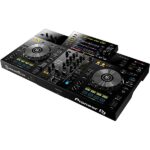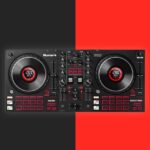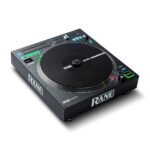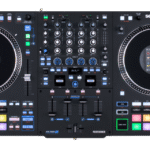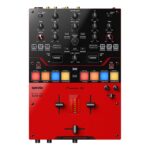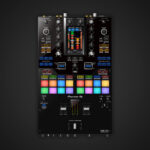Expert review of the Pioneer DDJ-SB3 Serato DJ Lite controller. Features breakdown, pad scratch mode, effects, build quality, performance pads, and pros/cons. Ideal for beginners and those upgrading from DDJ-SB2.
Pioneer DDJ-SB3 Controller Review: Entry-Level Excellence with Creative Pad Scratch
The Pioneer DDJ-SB3 offers an accessible yet powerful gateway into Serato DJ Lite, designed for aspiring DJs who want quality features, creative flexibility, and modern performance tools at a budget-friendly price. This in-depth editorial review explores the SB3’s design, performance modes, unique pad scratch feature, software integration, and its position in the entry-level controller market.
Plug-and-Play Simplicity
With seamless USB connectivity and native support for Serato DJ Lite, the DDJ-SB3 is truly plug-and-play. There’s a dedicated RCA master out for speakers, a microphone input with its own level control, and an eighth-inch headphone port on the front for cueing with standard headphones.
Reliable Hardware Performance
Tactile cue and play buttons mark a notable upgrade over the rubber pads found on the older SB2, offering precise control and a comfortable feel. The jog wheels are responsive and well-sized for scratching, beatmatching, and nudging tracks in the mix. They feature vinyl mode toggling, allowing for realistic scratching or nudging as needed.
Pitch/Tempo Fader
Despite its compact design, the SB3 offers a highly responsive tempo fader. You can adjust tracks by as little as 0.02% — an unusually fine increment for entry-level gear. DJs can switch between +/-8%, +/-16%, and even +/-50% tempo ranges (via shift + key lock) for more extreme transitions, though standard mixing typically happens at the lower settings.
Mixer Section and Effects
The mixer mirrors professional Pioneer layouts: 3-band total kill EQ, channel faders, crossfader (with curve settings in Serato), and dedicated filter knobs that effectively shape each track for blending or creative breakdowns.
Track library browsing and loading is simple, with well-positioned load buttons and browse pot.
Looping, Effects, and Flexibility
Auto loop modes are intuitive. DJs can select 1, 2, 4, or 8 beat loops, halving/doubling as needed, or jump directly to manual in/out points. Loop lengths can be changed during playback for dynamic mix routines, and relooping is speedy via the auto loop button. Effects options within Serato DJ Lite are basic but effective, offering three simultaneous effects per deck, with beat fraction settings accessible via shift.
Performance Pads: Hot Cue, FX Fade, Pad Scratch, Sampler, and More
- Hot cues: Easily set, trigger, and delete cue points throughout a track, facilitating jump mixing, beat juggling, and quick recovery mid-set.
- FX Fade: A range of automated transition effects (high-pass, low-pass, echo out, build-up effects) make mixing smooth, even for beginners. Automated filter sweeps and echo outs help add energy and clarity to transitions with a single tap.
- Pad Scratch: Pioneered in collaboration with DJ Jazzy Jeff, pad scratch mode applies pre-programmed scratch techniques on the first hot cue when holding any of the dedicated scratch pads. This feature is BPM-aware, adjusting scratch sounds to the current tempo, allowing beginners to add turntablism elements to their sets. While it’s not a substitute for manual scratching (lacking swing/rhythm nuance), it’s a valuable teaching tool and a fun way to introduce new DJs to scratching concepts.
- Sampler and Trans Mode: Samplers are loaded via Serato’s software and triggered on the performance pads. Vocal shots, drum hits, or DJ tags become part of your creative toolkit.
- Trans effect mode (activated via shift + sampler) silences tracks at preset beat fractions, adding rhythmic gate effects for dynamic drop-ins or breakdowns.
Serato DJ Pro Expansion
Upgrading to Serato DJ Pro ($99) unlocks more pad modes: beat jump, roll, slicer, slip mode, and increases the hot cue count to eight per deck. This expands the SB3’s creative range, making it suitable for intermediate DJ routines and more advanced performances.
Build Quality, Layout, and Price
The SB3 boasts thoughtful design improvements over the SB2: play/cue buttons, symmetrical tempo fader placement, and rearranged mixer sections, minimizing accidental nudging during scratches. While the controller is mostly plastic, build quality exceeds expectations for the segment.
The SB3 retails at approximately £229, offering unbeatable value for entry-level DJs, and justifying the upgrade from SB2 for its improved controls, pad scratch mode, and effect flexibility.
Pros
- Highly responsive jog wheels and tempo faders
- Intuitive layout for beginners
- Innovative pad scratch mode for quick turntablism
- Tactile cue/play buttons
- Smooth filter and effect integration
- FX fade simplifies transitions
- Expandable via Serato DJ Pro
Cons
- Plastic build; not ideal for rugged gigging
- Pad scratch mode can sound robotic if overused
- Limited native support outside Serato DJ Lite/Pro
- Creative pad modes require Pro expansion
Editorial Verdict: Who Should Consider the DDJ-SB3?
The Pioneer DDJ-SB3 is ideal for new DJs seeking a well-equipped, beginner-friendly controller with room to grow. Its unique pad scratch mode and FX fade transitions help users rapidly develop mixing and scratching skills, while seamless integration with Serato’s ecosystem ensures smooth performances and easy library management. Those upgrading from the SB2 will find substantial improvements in pad quality, layout, and overall usability. If you’re ready to elevate your mixing and want features that foster creativity, the SB3 is a wise investment — delivering exceptional value and paving the way for further advancement in DJing.





